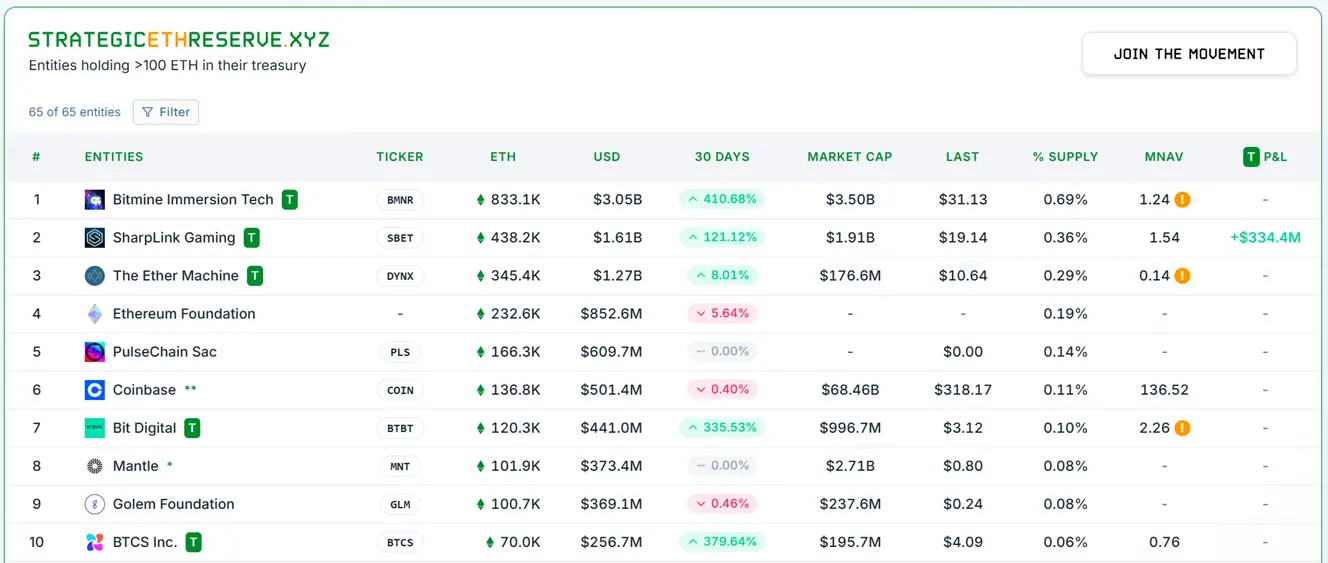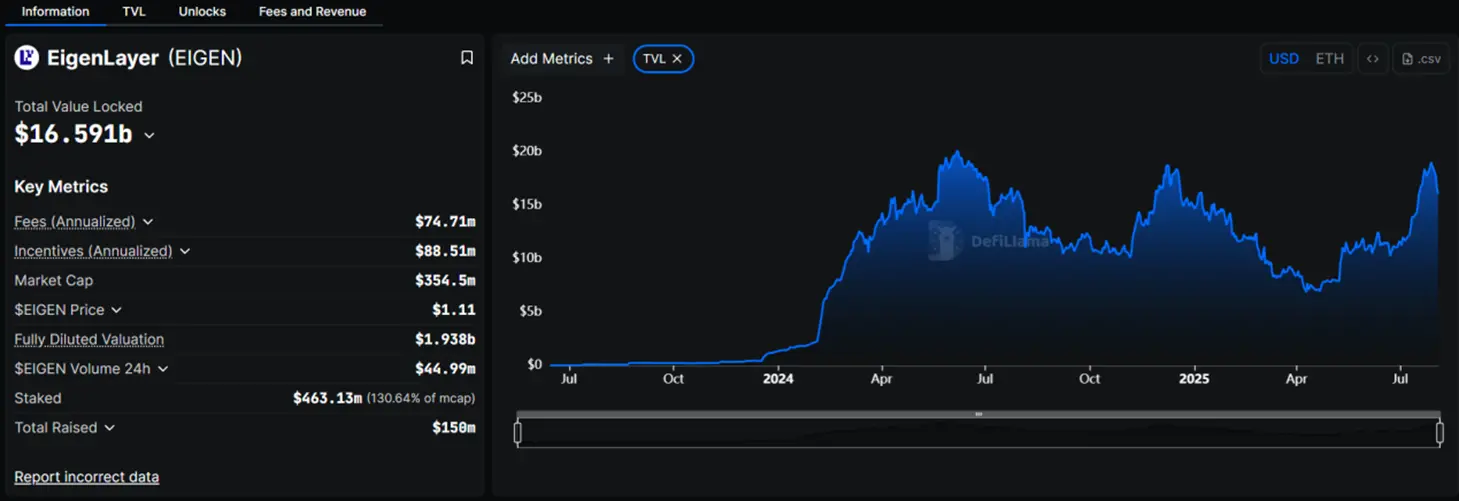Author: Zz, ChainCatcher
On August 4, the Ethereum treasury strategy company The Ether Machine (hereinafter referred to as ETHM) announced that it had increased its holdings by 10,605 ETH, bringing its total Ethereum holdings to 345,362 ETH, valued at approximately $1.27 billion. This marks the second large-scale increase for the company within less than a month of its listing.
As a company focused on Ethereum investment, ETHM announced its plans to go public on Nasdaq in July, initially aiming for 400,000 ETH, with a market value of nearly $1.6 billion. By the end of July, the company had already made a previous purchase of 15,000 ETH.
The Ether Machine's aggressive expansion comes at a critical time when several listed companies are competing to acquire ETH. With an increasingly clear regulatory framework, more and more listed companies are incorporating ETH into their asset allocations.
Holding $1.6 Billion in Ammunition, Entering the Ethereum DAT Arms Race
The Ethereum treasury track has become a battleground for institutions. ETHM's listing has ignited this competition—within just two weeks, the entire landscape of the sector has undergone a dramatic change.
According to official reports, when ETHM announced its listing on July 21, BitMine and SharpLink had ETH reserves of only 300,000 and 280,000 respectively, both below ETHM's planned initial scale of 400,000. However, by August 5, BitMine's holdings had surged to 833,000 ETH (valued at $3 billion), an increase of 177%, taking the lead; SharpLink also did not lag behind, with on-chain data from Nansen showing its reserves reaching 498,000 ETH (valued at $1.8 billion), an increase of 78%, ranking second and publicly announcing its goal to reach 1 million ETH. Even former Bitcoin miner Bit Digital has urgently pivoted, accumulating 120,000 ETH.

Image source: Strategic ETH Reserve (SBET data not yet updated)
This frenzy of accumulation confirms Standard Chartered's prediction: treasury companies have purchased over 1% of the circulating ETH supply, and this proportion could soar to 10%. A multi-billion dollar "arms race" is fully escalating.
In this heated competition, The Ether Machine stands out with its dual advantages of "capital + strategy." First, the nearly $1.6 billion in initial capital provides substantial ammunition—Andrew Keys personally invested $645 million in ETH, and institutions like Pantera Capital have pledged over $800 million in financing. But this alone is not enough to ensure its success.
The more critical advantage lies in its differentiated approach. While competitors are frantically hoarding coins to capture market share, ETHM has enhanced its yield to 4-5.5% through re-staking and DeFi protocol combinations. In a low-interest-rate environment, this stable high yield has become a "killer app" for attracting institutional funds.
Annualized 4-5.5%, Dissecting ETHM's Golden Strategy
To understand how The Ether Machine achieves an annualized return of 4-5.5%, one must grasp its core positioning as an "Ethereum generation company."
This concept can be likened to the oil economy: traditional crypto investment is akin to buying crude oil and hoarding it for price appreciation; whereas The Ether Machine chooses to become an "oil company," generating cash flow from the assets themselves.
Keys and his team discovered that ETH is not just an asset but also a production tool. Through the EigenLayer protocol, staked ETH achieves "multiple benefits"—providing security for the Ethereum mainnet while simultaneously serving protocols like oracles and cross-chain bridges, each service generating additional revenue.
It's like bank deposits that not only earn interest but can also "work" to earn extra income. The total locked value of EigenLayer at $16.591 billion validates the appeal of this model, and The Ether Machine has become one of the largest institutional participants in this ecosystem.

In addition to re-staking yields, the company also gains returns by participating in DeFi protocols. When the basic staking yield for ETH is only about 3%, this combined strategy boosts total returns to 4-5.5%.
Thus, ETH has transformed from a static asset "waiting for appreciation" to a productive asset that "continuously creates value."
ETHM is Not the Next MicroStrategy
The market always likes to find points of reference. When The Ether Machine emerged, almost everyone asked the same question: "Is this the next MicroStrategy?"
"Perhaps people tend to understand today's innovations through the framework of yesterday."
Indeed, on the surface, both companies seem to be doing the same thing—holding large amounts of crypto assets as publicly listed companies. However, a deeper look reveals that they are employing completely different methods.
MicroStrategy's logic is simple and blunt. It issues bonds to buy Bitcoin, betting that the price will rise to cover interest. However, the efficiency of this model is rapidly declining. In 2021, MicroStrategy could generate one basis point of return for shareholders with every 12.44 BTC. By July 2025, it will require 62.88 BTC to achieve the same effect. The scale has increased fivefold, but efficiency has dropped to one-fifth.
In contrast, The Ether Machine is taking a different path. Through staking and DeFi participation, ETH generates approximately 5% annualized cash flow daily. There is no need to wait for the price to rise or pray for a bull market—this is real income, not paper wealth.
The fundamental difference lies in the nature of the assets: Bitcoin is digital gold, its value stemming from scarcity and consensus. Ethereum, on the other hand, is digital infrastructure, its value derived from its ability to support the operation of the entire ecosystem.
We can now trace back to the MicroStrategy era and find that we are experiencing the third phase of the evolution towards crypto treasuries:
Phase 1: Pioneer Dividend Period (2020-2023) During this time, the previously underestimated MicroStrategy proved that publicly listed companies could gain a premium by holding crypto assets.
Phase 2: Model Replication Period (2024-2025) Successful imitators emerged. The imitative SharpLink's stock skyrocketed 4000% before plummeting 70%. Marathon Digital and Riot Platforms followed suit, but with poor results, exposing the risks of a simple hoarding model.
Phase 3: Model Evolution Period (2025-) A new model represented by The Ether Machine—not hoarding assets, but operating assets to create diversified income sources.
However, achieving this evolution from hoarding assets to operating assets is no easy task. It requires not only a profound understanding of the crypto world but also experience navigating the compliance maze of traditional finance.
Four Key Players Behind the Giant
"The Ethereum Avengers"—when the chairman of The Ether Machine used this term to describe the team, it was no exaggeration. This group of well-connected "Avengers" is attempting to reshape the landscape of institutional crypto investment.
The story begins with the "forge" of the Ethereum ecosystem, ConsenSys. There, Andrew Keys and David Merin first met. At that time, they had no idea they would become deeply intertwined with top financial institutions worldwide.
In 2017, during the "crypto winter" following the ICO bubble burst, the entire industry was filled with despair. At this moment when everyone was fleeing, Andrew Keys aimed to use Ethereum to open doors to Microsoft and JPMorgan.
"The way they looked at Andrew Keys was like looking at a madman selling a perpetual motion machine."
But he did not give up. After countless rejections and explanations, skepticism slowly turned into curiosity. Ultimately, he founded the Enterprise Ethereum Alliance (EEA), bringing the term "Ethereum" into the boardrooms of Fortune 500 companies for the first time.
Meanwhile, David Merin was driving the commercialization transformation within ConsenSys, leading over $700 million in financing and acquisitions.
Through countless late-night discussions, the two realized that the gap between traditional finance and the crypto world was not just prejudice but a significant compliance chasm.
"Countless institutions are interested in Ethereum, but ultimately they stop due to a lack of credible investment tools."
This pain point prompted them to make a bold decision: to no longer just be "evangelists," but to personally step in and create a regulated financial vehicle.
Keys' first move shocked everyone—he invested over $600 million of his personal ETH as initial investment. "If I don't believe in it myself, how can I make others believe?"
His all-in stance demonstrated his determination. In a subsequent CNBC interview, he explicitly stated, "I would rather have an iPhone than a landline." This metaphor aptly explains why he only bets on Ethereum.
Next, the team began to assemble. They found Darius Przydzial, who had managed traditional risks at Fortress and was a core contributor to the DeFi protocol Synthetix—a "dual-sided" individual. His task was clear: to strike gold in the wild west of DeFi while also staying alive.
For technical security, Tim Lowe, who has twenty years of experience in banking-level systems, joined the team. Finally, the arrival of Jonathan Christodoro, a PayPal director and former Icahn Enterprises executive, provided the final endorsement for the company's governance structure.
The internal team dynamics were not smooth sailing. The traditional finance faction advocated for conservative stability, while the crypto-native faction leaned towards radical innovation. After numerous debates yielded no results, Keys made a decisive statement: "We are not choosing a side; we are to be the bridge connecting both sides."
This statement became The Ether Machine's unchanging core philosophy.
Vitalik's Call: We Should Not Rush to Pursue Large Institutional Capital
If the Ethereum Foundation represents the idealism centered on technology and community, forming the first lifeline of ETH, what we witness today is the natural evolution and handover of this lifeline: as the EF gives way to capital, ETH's second lifeline has already begun.
This new lifeline does not necessarily deviate from the original intention, but it will undoubtedly lead Ethereum into a more complex deep water zone. The question is, what will Ethereum become in this process? What risks will it face?
The foremost risk is technical: smart contract vulnerabilities and staking penalties could lead to a 100% loss of ETH, coupled with a lengthy unlocking period, making liquidity a luxury. When a single entity controls a large amount of ETH, are we strengthening Ethereum or changing its essence?
Subsequently, community opinions have shown clear divisions. A comment from @azuroprotocol accurately captured this anxiety: from "building a decentralized Ethereum" to "selling 400,000 ETH to enterprises," it ultimately evolved into "Web3 becoming Wall Street 2.0."
Even Vitalik has issued a warning: "We should not rush to pursue large institutional capital." Now, as 70% of staked ETH is concentrated in a few pools, is his concern becoming a reality?
At the same time, "when prices rise, who still cares about decentralization?" @agentic_t succinctly articulated the core dilemma of the community. The 4%-5.5% staking yield seems enticing, but history tells us that all excess returns will eventually be arbitraged away.
Similarly, although Keys believes that Ethereum has become the biggest beneficiary of the GENIUS Act and that the regulatory spring seems to have arrived, what happens after the spring? When policy winds shift, will these institutional efforts become targets for regulation?
A Sign of Maturity or the End of Idealism?
Perhaps every successful technology ultimately moves towards institutionalization. The internet, mobile payments, and social media have all undergone this process.
As Ethereum transitions from an idealistic experiment to an investment product embraced by Wall Street, is this a sign of maturity or a departure from its original intention?
Time will provide the answer.
免责声明:本文章仅代表作者个人观点,不代表本平台的立场和观点。本文章仅供信息分享,不构成对任何人的任何投资建议。用户与作者之间的任何争议,与本平台无关。如网页中刊载的文章或图片涉及侵权,请提供相关的权利证明和身份证明发送邮件到support@aicoin.com,本平台相关工作人员将会进行核查。




